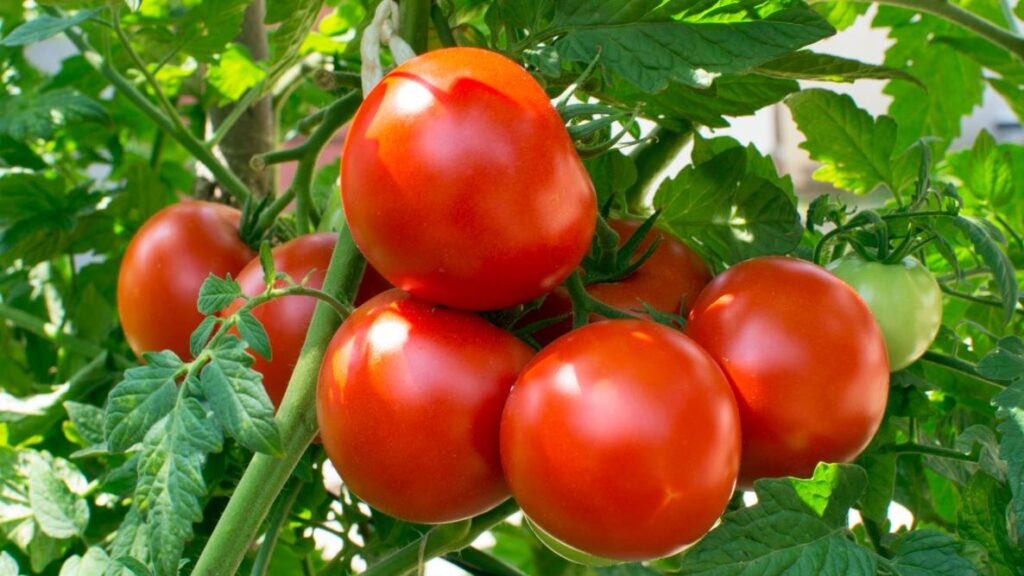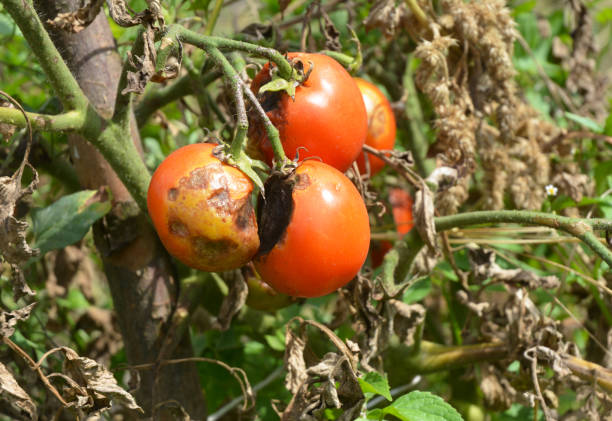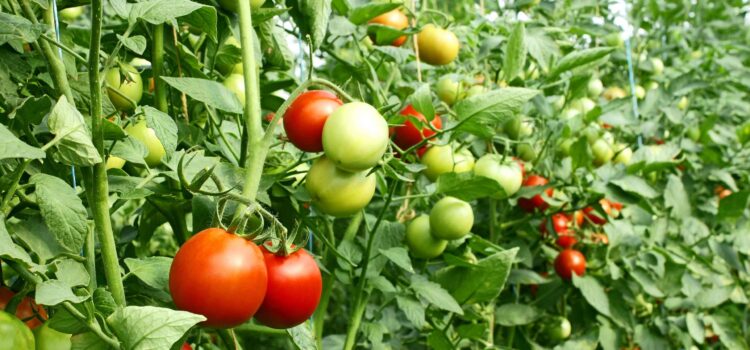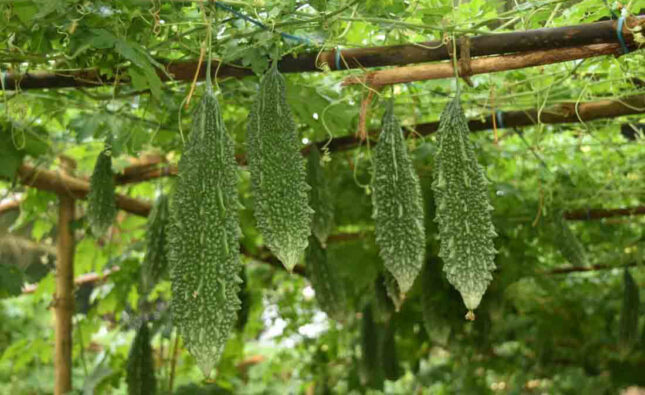All about tomato cultivation & Its Sells & Marketing
The tomato (Solanum lycopersicum) is a fruit that is commonly used as a vegetable in culinary preparations. It belongs to the nightshade family, Solanaceae. Tomatoes are native to western South America and were domesticated by indigenous peoples in Mexico. They were later introduced to Europe and other parts of the world through Spanish colonization.
Tomatoes are typically round or slightly oblong in shape and come in a variety of colors including red, yellow, orange, and even purple. They have a juicy flesh and a tangy, sweet flavor. Tomatoes are rich in nutrients such as vitamin C, vitamin A, potassium, and lycopene, which is a powerful antioxidant. Tomatoes are used in a wide range of dishes, including salads, soups, sauces, salsas, and stews. They can be consumed raw or cooked, and they are also commonly used in processed food products such as ketchup, tomato paste, and canned tomatoes.
In culinary terminology, tomatoes are often considered as vegetables, even though scientifically they are fruits. This is because they are typically used in Savory dishes rather than desserts.
Tomato farming
Tomato farming involves several aspects, from selecting the right variety to post-harvest handling. Here are more detailed pieces of information on tomato farming:
-
Variety Selection:
-
- Consider local climate conditions and market demand when choosing tomato varieties.
- Determine whether you need determinate or indeterminate varieties based on the desired harvest time and growth habit.
- Look for disease-resistant varieties to minimize the risk of common tomato diseases.
-
Seedling Production:
-
- Start tomato seeds indoors 6-8 weeks before the anticipated transplanting date.
- Sow seeds in trays or containers filled with a sterile seed-starting mix.
- Provide consistent moisture, warmth (around 70-80°F or 21-27°C), and adequate light for seedling development.
- Transplant seedlings into larger pots when they have developed their first true leaves.
-
Land Preparation and Planting:
-
- Clear the field of weeds, rocks, and debris.
- Conduct a soil test to determine pH and nutrient levels.
- Amend the soil with organic matter, such as compost or well-rotted manure, to improve fertility and structure.
- Create raised beds or ridges to enhance drainage and prevent waterlogging.
- Plant seedlings in the prepared soil, burying them up to the first true leaves.
-
Spacing
Spacing depends upon the type of variety grown and the season of planting. Normally the seedlings are transplanted at a spacing of 75-90 x 45-60 cm.
-
Method of Planting
Seedlings are transplanted in furrows in light soils and on side of the ridges in case of heavy soils. A pre-soaking irrigation is given 3-4 days prior to transplanting. Before planting seedlings should be dipped in a solution prepared by Nuvacron (15ml) and Dithane M – 45 (25g) in 10 litres of water for 5-6 minutes. Transplanting should preferably be done in the evening.
-
Irrigation:
-
- Provide regular and adequate water supply to ensure consistent soil moisture.
- Use drip irrigation or soaker hoses for efficient water delivery and to minimize foliar diseases.
- Irrigate in the morning to allow foliage to dry before evening, reducing disease risks.
-
Mulching and Weed Control:
-
- Apply organic mulch, such as straw or plastic film, to conserve soil moisture and suppress weed growth.
- Keep the planting area weed-free, as weeds can compete for nutrients, water, and light.
-
Fertilization:
-
- Conduct a soil test to determine nutrient deficiencies and adjust fertilization accordingly.
- Apply balanced fertilizers or organic amendments before planting based on soil test recommendations.
- Monitor plant growth and nutrient requirements throughout the season and apply side-dressings of nitrogen-rich fertilizers if necessary.
-
Pruning and Training:
-
- Remove suckers (side shoots) that emerge from leaf axils to focus the plant’s energy on fruit production.
- Train indeterminate varieties onto stakes, trellises, or other support systems to manage their growth and improve air circulation.
-
Pest and Disease Management:
-
- Monitor plants regularly for pests like aphids, whiteflies, hornworms, and diseases like blights, molds, and viruses.
- Employ integrated pest management (IPM) strategies, including cultural practices, biological controls, and targeted pesticide applications if necessary.
- Rotate crops to minimize the buildup of pests and diseases in the soil.
-
Fruit Harvesting and Handling:
-
- Harvest tomatoes when they reach their desired stage of ripeness, depending on market preferences.
- Handle the fruits carefully to prevent bruising or damage.
- Sort and grade the harvested tomatoes based on size, color, and quality.
- Store and transport the tomatoes under proper conditions to maintain freshness and extend shelf life.
-
Crop Rotation and Soil Management:
- Practice crop rotation to prevent the buildup of diseases and pests.
- Follow a rotation cycle of at least three years before replanting tomatoes in the same field.
- Implement soil conservation practices to prevent erosion and maintain soil health.
-
Post-Harvest Handling:
- Remove any damaged or spoiled tomatoes before storage or processing.
- Store tomatoes in a cool, dry place at temperatures around 55-60°F (13-16°C) to extend their shelf life.

Recommended Varieties of Tomatoes for Cultivation
- Released by IARI : Pusa Rohini, Pusa Sadabahar, Pusa Hybrid 8, Pusa Hybrid 4, Pusa Uphar, Pusa Hybrid 2, Sioux
- Released by IIHR : Arka Vikas, Arka Saurabh, Arka Meghali, Arka Ahuti, Arka Ashish, Arka Abha, Arka Alok, Arka Vishal, Arka Vardan, Arka Shreshta, Arka Abhijit
- Released by PAU : Pb. Kesari, Punjab Chhuhara, S-12, Sel-152, PAU-2372 ,
- Released by GBPUAT, Pantnagar : Pant T-10, AC-238, Pant T-3
- Others : H-24, H-86, Pusa Early Dwarf, CO-3, CO-1, BT-12,
Harvesting of tomatoes
Harvesting tomatoes at the right stage of ripeness is crucial to ensure good flavor, quality, and marketability. Here are the key steps for harvesting tomatoes:
-
Determine Ripeness:
- Monitor the fruit’s color change, which varies depending on the tomato variety. For most varieties, the fruit should reach its mature color (e.g., red, yellow, orange) before harvesting.
- Gently squeeze the tomato to check for a slight give or softness without being overly firm or mushy.
- Consider the fruit’s size and smoothness, as some varieties exhibit specific characteristics when fully ripe.
-
Harvesting Technique:
- Grasp the tomato gently but firmly, and with a slight twisting motion, detach it from the vine. Alternatively, you can use pruning shears or a sharp knife to cut the fruit from the stem, leaving a small stem attached.
- Be careful not to damage the fruit or nearby stems or leaves during the harvest process.
- Place harvested tomatoes in a clean container or basket to avoid bruising.
-
Harvest Timing:
- Harvesting time can vary depending on the tomato variety and the desired use of the fruit.
- Tomatoes intended for fresh consumption are typically harvested when fully ripe.
- If you plan to transport or store tomatoes, consider harvesting them slightly underripe, known as the “breaker stage,” when the fruit shows the first signs of color change. This helps reduce the risk of damage during handling and extends the shelf life.
-
Regular Harvesting:
- Conduct regular and frequent harvests, typically every few days, as tomatoes ripen at different rates.
- Inspect the plants thoroughly to ensure all ripe or nearly ripe tomatoes are collected, minimizing the risk of overripening or fruit drop.
-
Handling:
- Handle harvested tomatoes with care to prevent bruising or damage.
- Avoid dropping or piling tomatoes on top of each other.
- Place the harvested tomatoes in shallow layers to allow air circulation and minimize pressure on the fruit.
-
Sorting and Grading:
- After harvest, sort the tomatoes based on their size, color, and quality.
- Discard any damaged or spoiled fruits.
- Grade the tomatoes according to market standards or customer requirements, if applicable.
-
Post-Harvest Storage and Transport:
- If immediate sale or consumption is not possible, store tomatoes in a cool, well-ventilated area away from direct sunlight.
- Optimal storage temperature ranges from 55°F to 60°F (13°C to 16°C), which helps maintain fruit quality and extends shelf life.
- Avoid storing tomatoes in the refrigerator, as it can negatively affect their texture and flavor.
- During transportation, take measures to protect the fruit from excessive jostling or extreme temperatures. Prompt and proper harvesting of tomatoes helps ensure peak flavor and quality. Regular monitoring of the plants and adherence to appropriate handling and storage practices are essential to maximize the shelf life and market value of the harvested tomatoes.

Tomato Diseases and Its Management
Tomatoes are susceptible to various diseases that can impact plant health, fruit quality, and overall yield. Effective disease management strategies are crucial to minimize losses and maintain healthy tomato crops. Here are some common tomato diseases and their management:
-
Early Blight (Alternaria solani):
- Symptoms: Dark, concentric rings with yellowing and browning of leaves, lesions on stems and fruit.
- Management: Rotate crops, practice good sanitation by removing infected plant debris, apply fungicides as preventive measures, provide adequate plant spacing for airflow, and irrigate at the base of plants to avoid wetting foliage.
-
Late Blight (Phytophthora infestans):
- Symptoms: Dark, water-soaked lesions on leaves, stems, and fruit, often with a white, fuzzy growth in humid conditions.
- Management: Remove and destroy infected plants, practice good sanitation, provide ample spacing, apply fungicides preventively, and avoid overhead irrigation.
-
Fusarium Wilt (Fusarium oxysporum):
- Symptoms: Wilting of lower leaves, yellowing, stunted growth, vascular discoloration.
- Management: Plant resistant varieties, practice crop rotation, avoid overwatering, and manage soilborne pathogens through soil solarization or fumigation.
-
Verticillium Wilt (Verticillium spp.):
- Symptoms: Wilting, yellowing, and browning of lower leaves, vascular discoloration.
- Management: Plant resistant varieties, practice crop rotation, manage soil pH and fertility, and employ soil solarization or fumigation to control the pathogen.
-
Tomato Mosaic Virus (ToMV) and Tobacco Mosaic Virus (TMV):
- Symptoms: Mottled or mosaic patterns on leaves, stunted growth, distorted fruit.
- Management: Plant virus-resistant varieties, control aphid vectors, practice good sanitation, and avoid smoking or handling tobacco around tomato plants.
-
Bacterial Spot (Xanthomonas spp.):
- Symptoms: Dark, water-soaked lesions on leaves, stems, and fruit, often surrounded by a yellow halo.
- Management: Rotate crops, practice good sanitation, space plants for airflow, avoid overhead irrigation, and copper-based sprays can be used as preventive measures.
-
Powdery Mildew (Leveillula taurica or Oidium spp.):
- Symptoms: White, powdery fungal growth on leaves, stems, and fruit, leading to leaf curling and necrosis.
- Management: Provide good airflow through proper plant spacing, remove and destroy infected plant parts, apply fungicides as preventive measures, and avoid overhead watering.
-
Blossom End Rot:
- Symptoms: Dark, sunken lesions on the blossom end of the fruit.
- Management: Maintain consistent soil moisture levels through irrigation, ensure adequate calcium availability through soil amendments, and avoid excessive nitrogen fertilization.
-
Septoria Leaf Spot (Septoria lycopersici):
- Symptoms: Small, circular lesions with dark centers and yellow halos on lower leaves, leading to defoliation.
- Management: Practice good sanitation, remove and destroy infected leaves, provide proper plant spacing, and apply fungicides if necessary.
-
Gray Mold (Botrytis cinerea):
- Symptoms: Gray, fuzzy mold growth on plant tissues, especially in humid conditions.
- Management: Remove and destroy infected plant debris, provide good airflow, avoid excessive nitrogen fertilization, and apply fungicides preventively. Integrated Disease Management (IDM) is essential for effectively managing tomato diseases. It involves a combination of cultural practices, crop rotation, resistant varieties, sanitation, and, if necessary, the judicious

Sales And Marketing of Tomato
Sales and marketing play a crucial role in the successful commercialization of tomatoes. Here are some key considerations for the sales and marketing of tomatoes:
-
Market Research:
- Conduct market research to understand the demand, preferences, and trends in the tomato market.
- Identify potential buyers, such as retailers, wholesalers, restaurants, and food processors.
- Analyze the competition and pricing strategies in your target market.
-
Packaging and Labeling:
- Use appropriate packaging materials that ensure the freshness and protection of tomatoes during transportation and storage.
- Consider consumer preferences and industry standards for packaging sizes, such as clamshells, boxes, or bags.
- Create attractive labels that provide necessary product information, branding, and compliance with labeling regulations.
-
Branding and Positioning:
- Develop a strong brand identity that differentiates your tomatoes from competitors.
- Highlight the unique qualities of your tomatoes, such as taste, freshness, or sustainability practices.
- Communicate your brand story and values to connect with consumers and build trust.
-
Pricing Strategy:
- Determine a competitive yet profitable pricing strategy based on production costs, market demand, quality, and value perception.
- Consider factors such as seasonal variations in supply, market fluctuations, and local or regional pricing trends.
- Offer pricing incentives or discounts for bulk purchases or long-term contracts with buyers.
-
Distribution Channels:
- Identify the most suitable distribution channels based on your target market and scale of production.
- Establish relationships with wholesalers, distributors, or retailers who have access to your desired customer base.
- Explore direct-to-consumer channels such as farmers’ markets, community-supported agriculture (CSA), or online platforms.
-
Marketing and Promotion:
- Develop a comprehensive marketing strategy to create awareness and generate demand for your tomatoes.
- Utilize various marketing channels such as social media, websites, print media, and local advertising.
- Highlight the nutritional benefits, culinary versatility, and taste of your tomatoes in your marketing materials.
- Participate in industry trade shows, food festivals, or local events to showcase and sample your tomatoes.
-
Customer Relationships and Service:
- Build strong relationships with your customers by providing consistent quality, reliable supply, and excellent customer service.
- Respond promptly to customer inquiries, feedback, and complaints.
- Seek opportunities to engage with customers, such as offering recipe suggestions, cooking demos, or educational content related to tomatoes.
-
Quality Control:
- Implement stringent quality control measures to ensure that only high-quality tomatoes reach the market.
- Train and educate your staff on quality standards, grading, and sorting procedures.
- Regularly inspect and monitor the post-harvest handling, storage, and transportation processes to maintain product freshness and quality.
-
Certifications and Sustainability:
- Obtain relevant certifications, such as organic, fair trade, or sustainability certifications, to cater to specific consumer preferences and market segments.
- Highlight any sustainable farming practices or environmental initiatives associated with your tomato production.
-
Market Feedback and Adaptation:
- Gather feedback from customers, buyers, and industry stakeholders to understand their preferences, needs, and changing market dynamics.
- Use this feedback to continuously improve your product offerings, packaging, marketing strategies, and customer service. Remember, effective sales and marketing strategies should be tailored to your specific target market, customer segments, and business objectives. Stay adaptable and open to evolving market trends and consumer demands to stay competitive in the tomato industry.







